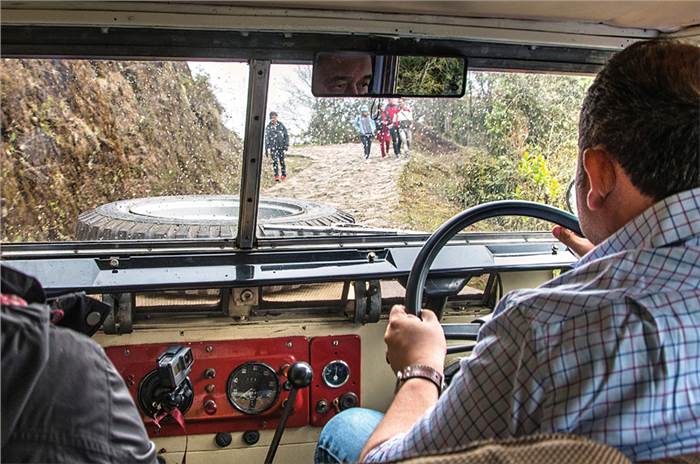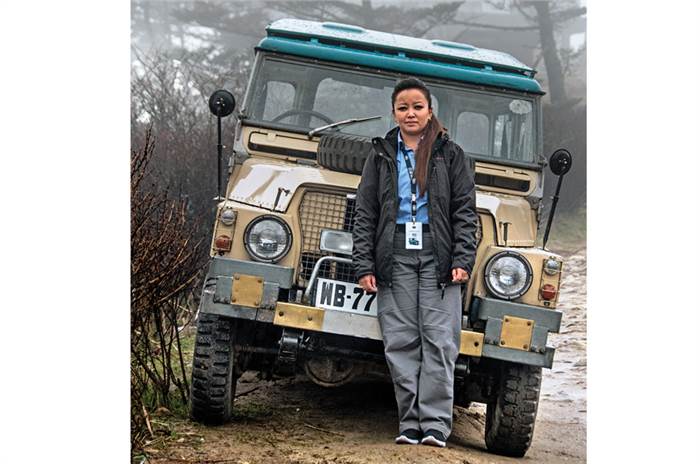70 years of Land Rover: Some like it rough
To celebrate 70 years of Land Rover, we take a Lightweight, based on a Series IIA, and the new Discovery for a bit of an extreme trip: up the side of a mountain.
Published On Jun 09, 2018 07:00:00 AM
12,781 Views
Follow us on“Land Rover is celebrating its 70th birthday,” says the thin voice at the end of the line, “we’d like you to join.” Now, normally, a celebration of this sort involves putting on a jacket, buffing my shoes and showing up at a gala dinner. But not here. What Land Rover has planned to celebrate its 70th is nothing short of crazy. The celebration is to be held 3.6km above the surface of the earth. And this isn’t any old hilltop. Turns out, this spot has plenty of significance for Land Rover.
Known simply as Sandakphu, from where the mighty Mt Kanchenjunga (8,586m) looms into view, it is a point Land Rovers have been making the difficult trek up to since the ‘60s. Locals estimate that at one time, there were at least 300 Series I and Series II Land Rovers in the region. Imported via a dealer in Calcutta, predominantly by British tea estate owners and ex-Army men in the ‘50s and ‘60s, many Land Rovers also came in via grants of the anti-communist Colombo Plan.

Now, as time passed, they should have disappeared or dissolved into cracks in the ground. But fate had other plans. For one, rot didn’t set in – Landies have aluminum bodies. And since they were so capable and could traverse Himalayan passes easily with their low-range gearboxes, transporters started using them as light commercial vehicles, moving all manner of cargo and passengers between India and Nepal. So these Land Rovers got a second life. And then because they were built so tough and had a chassis that could handle the daily pounding with ease, they lasted and lasted and lasted.
The old donkey trail we are about to drive up stretches from Maney Bhanjyang (1,928m) and runs through the Singalila National Park before finally summiting at Sandakphu (3,636m). The gradient is super steep. The road rises a massive 1.7km up, in just 31km, and it is so steep in places; it’s one of the few places in India where two-wheelers are banned. Want to ride up here on your Bullet? Forget it.

The biggest shock, however, is the time warp that takes place when we arrive at our jump-off point, Maney Bhanjyang – this place is just crawling with Land Rovers. It is said that there are now
around 40 in active service, but it seems like there must be more. I see over two dozen in just 10 minutes. This clearly is the land of the Land Rover. There are Series I, Series II and Series III models all around. Looking like prizefighters, these battered and bruised taxis are not in Concours condition, but what their warts and battered panels give them is a patina and genuineness that is even more appealing.
Now it’s time to saddle up and hit the road. Our mount for today is a Discovery – Land Rover’s most capable off-roader right now. And later in the day, I’ll get to drive one of the old Land Rovers as well. On the way out of Maney Bhanjyang, I catch a glimpse of a garage that obviously repairs the old Land Rovers and I can’t resist a quick chat with the proprietor. Turns out, he is the head of the Singalila Land Rover Association. What a stroke of luck! “What makes these cars go on and on?” I ask, straight up. “The chassis is much stronger than other off-roaders I’ve seen,” he says. “The suspension and diff are overbuilt, and what helps is that the light body reduces the load on all the components.” “And just where do you manage to get parts?” I ask. “We’ve broken almost a hundred cars here,” he states, “and we keep and repair almost everything.”

I get behind the wheel of the Discovery and head in the direction the others have taken. But this seems like a mistake. The road feels as narrow as a by-lane; it bends back and away from where we are, and then soon narrows even further, making the Disco feel like an elephant in an alley. The path is so narrow in places, you have to be careful of scuffing the left tyre against the mountain wall and going off the road on the right. This is just crazy. Yes, there are a few bollards and a few low walls too, but you are often so close to the edge, it’s enough to give anyone vertigo.
The initial bit of road has been paved and there are some dimples for extra grip, but some of the inclines are so steep and some U-turns so tight, I’m often driving up blind. As if this wasn’t unnerving enough, some of the hairpins are so tight, you need to reverse before you can make it around.

The 2.2-ton weight of the Disco, however, isn’t a problem. Not with the 340 supercharged horses and 450Nm of torque stampeding out to the wheels. In fact, there’s so much power, I revert to the regular road setup; there’s no need to select a special rock-crawling mode on the Terrain Response dial. Yes, at times, the inside rear wheel chirps and spins, but the Disco, with its responsive bottom-end and the extra weight over the rear axle (due to the incline), has loads and loads of traction.
Allowing a car to pass in the opposite direction is nothing short of a nightmare, though. I use the 360-degree cameras and the Drive Assist view to see exactly where my wheels are, and the mirrors are a great help too, but what gives me the chills is that, occasionally, some part of the tyre is literally off the edge. Mama!

We stop at a village further up for a cup of tea and some banter about the road, and this is followed by me jumping into a Lightweight or military version. A relatively rare type that was pared down to enable it to be transported by a helicopter or cargo plane on a pallet, the ‘Airportable’, as it was also called, is not just lighter, but significantly narrower too.
Before I get into the driver’s seat, however, I need some ‘type certification.’ My instructor for the day is the owner of the vehicle, and a brilliant driver – the grand-daughter of one of the most famous drivers to regularly tackle this pass. The Lightweight has been in her family for three generations.
As soon as we set off, memories of my first Land Rover drive come flooding in – the initial purr of the petrol engine, the manner in which the Landie hops over some of the bumps, the snick-snick of the gearbox. Ahh, it’s like meeting an old friend again.

The terrain is flat for a bit but Samantha starts off in low range.”It’s safer like this,” she explains, “because once you stall on a steep hairpin, it’s very difficult to get going again. And then you have to reverse down, without being able to see the edge of the road.” Faultless logic. Soon the relatively flat bits are over and we start climbing again.
She keeps the engine revs up now, so the din from under the bonnet is considerable. There’s a mechanical cacophony emanating from under the hood, the reduction gear whines away below the floor, and when she lifts off the throttle and coasts, I can hear the differential humming as well.
She seems worried when we swap seats. With good reason; these old girls are a far cry from modern cars. And then because the seat can’t be moved forward or back, I have to drive with my legs severely bent. The engine, however, responds well. With max torque coming in at just 1,500rpm and the largish 2.25-litre capacity, it feels torquey too. I start off in second due to the fact that it is in low range, and the Lightweight pulls up the incline almost with ease. I swap to third quickly, the light gear lever going clack-clack. But then as the incline becomes steeper, I need to come down to second. Now difficult-to-find gears are a regular feature on old British cars of the ‘50s; just ask anybody who’s driven an Ambassador. And second, as a result, is difficult to find. So difficult, it’s, well, . . .disappeared; gone completely. Back to ‘Blighty’. After what feels like attempt number 35, it finally slots in. Ahhhh, you need to pull it down and across, at an angle. Soft metal. Rats. What also needs a bit of muscle memory is the steering wheel. Heavy, slow and not too dissimilar from a tugboat, it makes the Lightweight feel like it weighs three tons. Now, this would be alright, normally. But here, when you need to go from lock to lock at a slow speed every few seconds, this as good as a cardiovascular workout as you can get for the upper body. Biceps, triceps, chest, shoulders, traps, wings, serratus; it works them all.

As we travel further up the road, I start to get more comfortable behind the wheel. Finding second now is not so much of a hit and miss; I often don’t use the clutch (only allowing for a pause to let the revs drop and match, before slotting the gear in) and my right leg gets used to smashing the brake pedal in, every time I need to slow down a bit. And it’s only then that I truly begin to appreciate it. What’s amazing is that keep it in the right gear and at the right engine speed and it climbs effortlessly, the low weight and torquey nature of the engine working well together. The tall springs are unfazed even by the roughest bits, and, even then, when you crash the suspension through some large ditches, the thump barely registers. Sure, the aluminum panels act as soundboards and there are plenty of rattles and unwanted mechanical noises, but I do finally understand, somewhat, how these Landies manages to take on this donkey trail, day after day, and survive.
What an amazing machine. What a tough little rascal. And remember most of the design is 70 years old. Happy Birthday, LR; you will have many, many more. And yes, when you start off with such fantastic genes, you do have a special advantage. Can’t wait to see the new Defender, now that I understand the bloodline so much better.
A LIVING TESTAMENT

Samantha Dong, who’s Lightweight we drove, has Land Rovers in her blood. Her grandfather was one of the earliest drivers on this road and one of the most fearless. He would often make five or even six trips a day to Sandakphu, transporting all manner of things from people to potatoes. Samantha says it was her father who taught her to drive on this trail and that she had to practise a lot before she could master tricks like heel and toeing (brake and accelerator) to keep the car in control.
Copyright (c) Autocar India. All rights reserved.






Comments
Member Login
Personal Details
No comments yet. Be the first to comment.